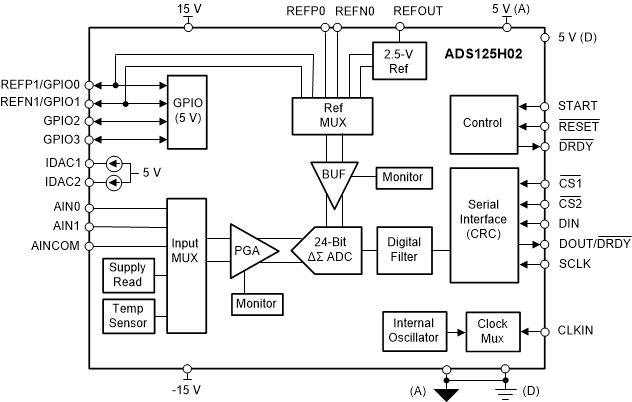-
ADS125H02 PGA および電圧リファレンス搭載、 ±20V 入力、2 チャネル、40kSPS、24 ビット、デルタ・シグマ ADC
- 1 特長
- 2 アプリケーション
- 3 概要
- 4 改訂履歴
- 5 概要(続き)
- 6 Device Comparison Table
- 7 Pin Configuration and Functions
- 8 Specifications
- 9 Parameter Measurement Information
-
10Detailed Description
- 10.1 Overview
- 10.2 Functional Block Diagram
- 10.3 Feature Description
- 10.4 Device Functional Modes
- 10.5 Programming
- 10.6
Register Map
- 10.6.1 Device Identification (ID) Register (address = 00h) [reset = 6xh]
- 10.6.2 Main Status (STATUS0) Register (address = 01h) [reset = 01h]
- 10.6.3 Mode 0 (MODE0) Register (address = 02h) [reset = 24h]
- 10.6.4 Mode 1 (MODE1) Register (address = 03h) [reset = 01h]
- 10.6.5 Mode 2 (MODE2) Register (address = 04h) [reset = 00h]
- 10.6.6 Mode 3 (MODE3) Register (address = 05h) [reset = 00h]
- 10.6.7 Reference Configuration (REF) Register (address = 06h) [reset = 05h]
- 10.6.8 Offset Calibration (OFCALx) Registers (address = 07h, 08h, 09h) [reset = 00h, 00h, 00h]
- 10.6.9 Full-Scale Calibration (FSCALx) Registers (address = 0Ah, 0Bh, 0Ch) [reset = 00h, 00h, 40h]
- 10.6.10 Current Source Multiplexer (I_MUX) Register (address = 0Dh) [reset = FFh]
- 10.6.11 Current Source Magnitude (I_MAG) Register (address = 0Eh) [reset = 00h]
- 10.6.12 Reserved (RESERVED) Register (address = 0Fh) [reset = 00h]
- 10.6.13 MODE4 (MODE4) Register (address = 10h) [reset = 50h]
- 10.6.14 PGA Alarm (STATUS1) Register (address = 11h) [reset = xxh]
- 10.6.15 Status 2 (STATUS2) Register (address = 12h) [reset = 0xh]
- 11Application and Implementation
- 12Power Supply Recommendations
- 13Layout
- 14デバイスおよびドキュメントのサポート
- 15メカニカル、パッケージ、および注文情報
- 重要なお知らせ
DATA SHEET
ADS125H02 PGA および電圧リファレンス搭載、 ±20V 入力、2 チャネル、40kSPS、24 ビット、デルタ・シグマ ADC
このリソースの元の言語は英語です。 翻訳は概要を便宜的に提供するもので、自動化ツール (機械翻訳) を使用していることがあり、TI では翻訳の正確性および妥当性につきましては一切保証いたしません。 実際の設計などの前には、ti.com で必ず最新の英語版をご参照くださいますようお願いいたします。
1 特長
- ±20V の入力範囲、24 ビットのデルタ・シグマ ADC
- データ・レートをプログラム可能:2.5SPS~40kSPS
- 高電圧、高インピーダンスの PGA
- 差動入力範囲:最大±20V
- プログラム可能ゲイン:0.125~128
- 同相入力電圧:最大±15.5V
- 入力インピーダンス:1GΩ (最小値)
- 高性能 ADC
- 入力ノイズ:45nVRMS (20SPS)
- CMRR: 105dB
- 50Hz、60Hz での通常モード除去:95dB
- オフセット・ドリフト係数:5nV/°C
- ゲイン・ドリフト係数:1ppm/°C
- INL: 2ppm
- 搭載機能および診断能力
- 2.5V の基準電圧:ドリフト係数 3ppm/°C
- クロック発振器:誤差 2.5% (最大値)
- 励起電流源
- GPIO による外部マルチプレクサ駆動
- 信号および基準電圧モニタ
- 巡回冗長性検査 (CRC)
- 電源
- AVDD:4.75V~5.25V
- DVDD:2.7V~5.25V
- HVDD:±5V~±18V
- 動作温度範囲:-40°C~+125°C
- 5mm × 5mm VQFN パッケージ
2 アプリケーション
- PLC アナログ入力モジュール
- 電圧 (例:±10V、0V~5V)
- 電流 (例:シャント付きで 4mA~20mA)
- 温度 (例:RTD、熱電対)
- 試験/測定機器
- 高い同相電圧入力
- バッテリのテスト
- ハイサイド電流測定
3 概要
ADS125H02 は ±20V 入力、24 ビットのデルタ・シグマ (ΔΣ) アナログ/デジタル・コンバータ (ADC) であり、低ノイズ・プログラマブル・ゲイン・アンプ (PGA)、内部リファレンス、クロック発振器、信号/リファレンス・アウトオブレンジ・モニタを搭載しています。
広い入力範囲、±18V PGA、ADC を 1 つのパッケージに統合しているため、ディスクリート・ソリューションよりも基板面積を最高 50% も削減できます。
ゲインを 0.125~128 の範囲でプログラム可能 (±20V~±20mV の等価な入力範囲に対応) なため、外部アッテネータや外部ゲイン段が不要です。1GΩ 以上の入力インピーダンスが、センサの負荷による誤差を低減します。さらに、ノイズが低くドリフトも小さいため、ブリッジ、測温抵抗体 (RTD)、熱電対センサに直接接続できます。
デジタル・フィルタにより、50SPS 以下または 60SPS 以下のデータ・レートについて、50Hz および 60Hz のライン・サイクル・ノイズが減衰し、測定誤差を減らします。さらに、このフィルタは変換データをレイテンシなしで供給するため、チャネルのシーケンシング時に高いデータ・スループットが得られます。
製品情報(1)
| 型番 | パッケージ | 本体サイズ(公称) |
|---|---|---|
| ADS125H02 | VQFN (32) | 5.00mm×5.00mm |
- 利用可能なすべてのパッケージについては、このデータシートの末尾にある注文情報を参照してください。
機能ブロック図

4 改訂履歴
Changes from B Revision (April 2019) to C Revision
- Deleted ドキュメントから ADS125H01 をGo
- Changed Device Comparison TableGo
- Added Effective resolution parameter to Electrical Characteristics tableGo
- Added Offset Voltage Long-Term Drift curves to Typical CharacteristicsGo
- Added Gain Long-Term Drift curves to Typical CharacteristicsGo
- Added Internal Reference Voltage Long-Term Drift curve to Typical CharacteristicsGo
- Added Oscillator Frequency Long-Term Drift curve to Typical CharacteristicsGo
- Changed Noise Performance sectionGo
- Added effective resolution and noise-free resolution data in Noise PerformanceGo
- Changed sinc1, sinc3, sinc4, and sinc5 values and footnote in Conversion Latency Time tableGo
- Changed start-conversion delay value from 0 µs to 50 µs in the Start-Conversion Delay sectionGo
- Changed sinc mode values in Calibration Time tableGo
- Changed address 00h default value from xxh to 6xh in Register Map Summary tableGo
- Changed reset value from xxh to 6xh in Device Identification (ID) RegisterGo
Changes from A Revision (January 2019) to B Revision
- Changed ADS125H02 のステータスを「事前情報」から「量産データ」にGo